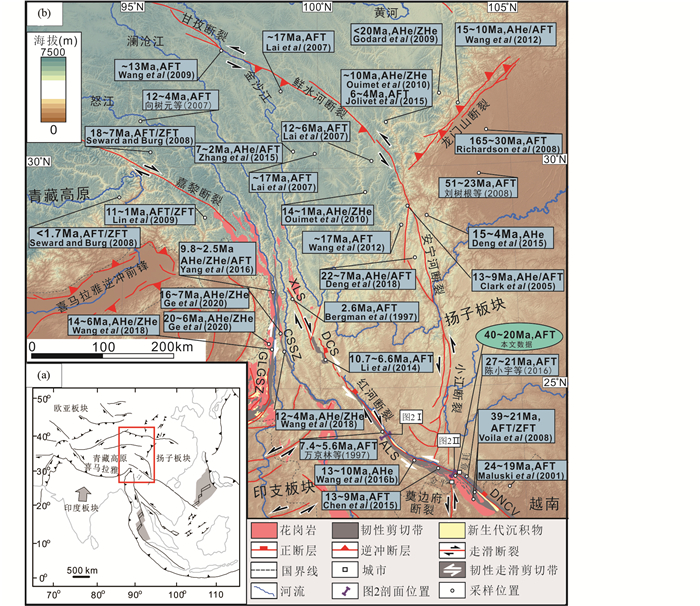2. 中国地震局地质研究所, 地震动力学国家重点实验室, 北京 100029;
3. 中山大学地球科学与工程学院, 地球动力学与地质灾害重点实验室, 广州 510275
2. State Key Laboratory of Earthquake Dynamics, Institute of Geology, China Earthquake Administration, Beijing 100029, China;
3. Guangdong Provincial Key Laboratory of Geodynamics and Geohazards, School of Earth Sciences and Engineering, Sun Yat-Sen University, Guangzhou 510275, China
新生代以来印度板块与欧亚板块的斜向汇聚、碰撞塑造了青藏高原和高原东南缘的构造地貌格局(Tapponnier et al., 1982;Leloup et al., 1995, 2001;Wang and Burchfiel, 1997;Clark et al., 2005, 2006;Royden et al., 2008;Xu et al., 2015),如三江地区的大型线性走滑剪切带:高黎贡走滑剪切带(Wang et al., 2008;Zhang et al., 2012)、崇山剪切带(Akciz et al., 2008;Zhang et al., 2010)和哀牢山-红河剪切带(Leloup and Kienast, 1993;Leloup et al., 1995;Searle, 2006;刘俊来等,2011;Liu et al., 2015)等(图 1)。其中,哀牢山-红河剪切带自喜马拉雅东构造结地区向东南延伸超过1000km,分割印支板块和扬子板块,是一条区域性构造边界(Leloup and Kienast, 1993;Leloup et al., 1995, 2001;Wang and Burchfiel, 1997;Searle, 2006;张进江等,2006;Liu et al., 2007)。
关于这些区域性走滑剪切带的作用和构造意义,Tapponnier et al.(1982)在其刚性块体侧向挤出模型中认为哀牢山-红河左旋韧性走滑剪切带与印支板块西侧的高黎贡右旋走滑剪切带作为东、西边界,共同调节印支板块的侧向挤出(中新世之前),即自上新世以来,哀牢山-红河剪切带转变为右旋走滑,调节扬子板块向东南的挤出(Tapponnier et al., 1982;Leloup et al., 1995)。然而这一刚性块体挤出模型无法解释青藏高原东南缘各微地块内部复杂的构造活动(徐锡伟等,2003)。随后,Wang and Burchfiel(1997)提出了地壳内部变形与旋转模式,认为印支板块在挤出过程中并非是一个整块刚性块体,而是众多非刚性块体以各自特有的运动方式旋转,且各块体只有在地壳缩短或地壳伸展的转换部位才能产生走滑断裂。这一旋转模式得到了大量古地磁数据的支持(Huang and Opdyke, 1993;Li et al., 2017, 2018),然而,Royden et al.(1997)提出的中、下地壳物质流动模型强调印度板块斜向汇聚与碰撞致使青藏高原内部地壳增厚和大量的中、下地壳物质发生部分熔融,这些熔融物质在自身重力势能作用下向青藏高原东南缘顺时针流动,从而导致青藏高原东南缘新生代发生了广泛的连续形变与地表抬升(Royden et al., 1997;Clark and Royden, 2000;Clark et al., 2005),同时中、下地壳物质流动为上地壳变形提供拖曳力,致使各块体边界之间的走滑断裂在中中新世后再次活跃,最为显著的是红河右旋走滑断裂和鲜水河-小江左旋走滑断裂重新启动(Roger et al., 1995;Replumaz et al., 2001;Schoenbohm et al., 2006;Wang et al., 2016b)。因此,精确厘定哀牢山-红河剪切带的构造变形方式、活动时限及其冷却历史是认识高原东南缘板内变形与地壳物质流变的重要内容。
哀牢山-红河剪切带呈NW-SE向展布,由四个不连续的变质杂岩带组成(图 1),分别是最北端的雪龙山杂岩带(Leloup and Kienast, 1993;Zhang et al., 2014, 2017),大理地区的点苍山杂岩带(Leloup and Kienast, 1993;Cao et al., 2011),沿红河西侧发育的哀牢山杂岩带(Harrison et al., 1996;Liu et al., 2015)以及越南境内的大象山杂岩带(Jolivet et al., 2001;Anczkiewicz et al., 2007;Viola and Anczkiewicz, 2008)。近三十年来,学者们对该剪切带内各变质杂岩带的中低温热演化历史和构造剥露机制开展了大量研究(Harrison et al., 1992, 1996;Leloup and Kienast, 1993;Leloup et al., 1995, 2001;万京林等,1997;Li et al., 2001;Anczkiewicz et al., 2007;Viola and Anczkiewicz, 2008;Cao et al., 2011;Wang et al., 2016b)。Harrison et al.(1996)和Leloup et al.(2001)通过分析哀牢山-红河剪切带各变质杂岩带构造变形特征和云母、斜长石的40Ar/39Ar热年代学,认为在大约32~17Ma期间,以云南弥渡为界,剪切带的雪龙山杂岩带和点苍山杂岩带以左旋韧性挤压走滑变形为主,并导致快速冷却剥露,而东南段的哀牢山杂岩带和大象山杂岩带以左旋走滑伸展变形为主,进而导致快速冷却剥露,且剥露过程自南东向北西具穿时性。在点苍山杂岩带,Cao et al.(2011)通过分析片麻岩中的云母40Ar/39Ar年龄,推测出点苍山杂岩经历三阶段冷却,即早期(28~21Ma)左旋走滑挤压作用控制的快速剥露,随后经历的慢速冷却剥露持续至13Ma,晚期(13~0Ma)的脆性走滑运动兼正断体制下的快速剥露。在哀牢山杂岩带,万京林等(1997)和Li et al.(2001)利用哀牢山带内糜棱岩化片麻岩中的角闪石、云母40Ar/39Ar年龄以及磷灰石裂变径迹年龄,提出哀牢山-红河剪切带的两阶段剥露模式,即早期(28~17Ma)以走滑伸展变形为主的剥露和晚期(15.5~5Ma)简单剪切变形体制下的剥露与冷却事件;Li et al.(2014)报道了点苍山和哀牢山嘎洒地区的磷灰石裂变径迹年龄,解释认为哀牢山杂岩带晚期(8.4~4.6Ma)快速剥露与正断层掀斜有关,而非简单剪切作用的结果;Chen et al.(2015)报道了哀牢山元江-元阳段在28~21Ma期间存在快速冷却事件,认为主要受纯左旋剪切运动控制,自21Ma后始终处于稳定的缓慢剥露过程;新近Wang et al.(2016b)基于糜棱岩中磷灰石U-Th/He年龄和已发表的40Ar/39Ar数据,提出哀牢山中段存在两期快速剥露和冷却事件,早期(27~17Ma)快速剥露与剪切带左旋韧性走滑有关,晚期(14~10Ma)受到青藏高原东南缘中、下地壳物质流动的影响。在大象山杂岩带,Anczkiewicz et al.(2007)与Viola and Anczkiewicz(2008)根据野外地质观测和磷灰石裂变径迹年龄特征,提出晚始新世到渐新世期间存在走滑伸展变形,从而使得大象山和周围部分片麻岩穹隆得以出露地表。
如上所述,哀牢山杂岩带内中、低温热年代学研究主要集中在该带北段和中段,而南段低温热年代学数据、冷却过程与剥露机制研究较少,且关于哀牢山杂岩渐新世-中新世期间的剥露机制和时限争议较大。本次研究,聚焦中国境内的哀牢山带南端蔓耗-金平地区,开展横穿剪切带的低温年代学分析,利用磷灰石进行LA-ICPMS裂变径迹测试和热史反演,以期揭示哀牢山杂岩带的冷却历史和剥露机制。
1 地质背景新生代以来,在印-欧板块碰撞的作用下,古老的哀牢山缝合带再次活动(张旗等,1995;Faure et al., 2014),在构造上表现为走滑剪切带(Tapponnier et al., 1982;Leloup et al., 1995;Wang and Burchfiel, 1997)将华南板块与印支板块分隔(Leloup et al., 1995, 2001;Schoenbohm et al., 2004;Wang et al., 2016a)。组成哀牢山-红河剪切带的四个杂岩带(雪龙山杂岩带、点苍山杂岩带、哀牢山杂岩带和大象山杂岩带)均表现出强烈糜棱岩化。宏、微观构造与结构观测表明,杂岩带核部呈线性片麻岩穹隆几何特征,翼部叠加强烈的左旋韧性走滑剪切(Jolivet et al., 2001;张进江等,2006;Viola and Anczkiewicz, 2008;Zhang et al., 2017)。在核部片麻岩内,面理倾角较缓,局部近水平,矿物拉伸线理平行于岩层走向呈水平或近水平分布特征(Leloup et al., 2001;Zhang et al., 2014, 2017);翼部糜棱岩面理发育,普遍呈陡倾角,倾向北东或北北东,面理上矿物拉伸线理发育,呈水平或近水平,与剪切带走向近平行(Leloup et al., 1995, 2001;Jolivet et al., 2001;Zhang et al., 2017)。
剪切带由核部高角闪岩相-角闪岩相片麻岩、混合岩以及两翼的绿片岩相云母片岩、变质砂岩等组成(Anczkiewicz et al., 2007;Liu et al., 2007;Cao et al., 2011;Zhang et al., 2017)。雪龙山杂岩带核部角闪岩相糜棱状片麻岩峰期变质条件是670℃、4.8kbar,而翼部变质条件是490℃、4.1kbar(孙志明等,2001)。哀牢山杂岩带岩性由南西侧低绿片岩相沉积变质岩(包括变质砂岩、变质粉砂岩、板岩、片岩等)、北东侧角闪岩相变质岩石(包括片麻岩、斜长角闪岩、大理岩等)组成(Leloup et al., 1995, 2001;Tang et al., 2013)。点苍山和哀牢山杂岩带核部片麻岩和混合岩的高角闪岩相-麻粒岩相(超过720~760℃,8.0~9.3kbar)变质作用发生在渐新世-中新世期(Leloup and Kienast, 1993;Leloup et al., 1995;Cao et al., 2011;Wang et al., 2016a),点苍山杂岩带低压变质作用则发生在625℃(Liu et al., 2007;Cao et al., 2011)。而Leloup et al.(2001)认为哀牢山杂岩带左旋韧性剪切作用的峰期变质条件为700℃和0.7GPa,退变质作用条件为480℃和0.3GPa,剪切带左旋走滑运动时限与同剪切淡色花岗岩岩脉一致,如,在点苍山杂岩带内,同剪切花岗岩脉体的U-Pb年龄为28~13Ma(Cao et al., 2011),哀牢山杂岩带元阳地区同剪切脉体U-Pb年龄为32~22Ma(Leloup et al., 1995, 2001;Searle et al., 2010),共同表明剪切带左旋韧性走滑剪切至少开始于渐新世(Harrison et al., 1996;Searle, 2006;Cao et al., 2011)。关于剪切带内高温剪切变形与长英质岩浆活动,Leloup et al.(2001)解释为左旋韧性剪切生热的结果,而Zhang et al.(2014, 2017)认为是深部地壳近水平剪切的结果,且水平剪切作用至少从33Ma持续至26Ma。云母和斜长石40Ar/39Ar年代学分析暗示点苍山和哀牢山杂岩带内片麻岩在22~17Ma期间快速冷却至250℃以下(Harrison et al., 1996;Cao et al., 2011)。磷灰石裂变径迹和磷灰石U-Th/He数据共同限定了哀牢山-红河剪切带最新一期的快速冷却剥露时限:万京林等(1997)和Li et al.(2001)报道了哀牢山杂岩带北-中段于15.5~5Ma冷却至110℃以下;Li et al.(2014)报道出点苍山和哀牢山北段分别在10.7~6.6Ma、8.4~4.6Ma期间冷却至近地表;新近Wang et al.(2016b)揭示出哀牢山北-中段片麻岩在14~10Ma快速冷却至60℃以下;Viola and Anczkiewicz(2008)报道了大象山杂岩带片麻岩在37~20Ma快速剥露至近地表。
2 样品采集本次研究横穿哀牢山剪切带,即蔓耗-金平剖面,共采集10件样品。样品海拔间隔150m,岩性为角闪岩相变质的糜棱岩化片麻岩(图 2)。在采样剖面的北东侧,红河断裂将三叠纪砂岩和新生代沉积物与糜棱状片麻岩分隔(图 2),南西侧就位大面积的Fan Si Pan花岗岩,该花岗岩内自东向西韧性剪切变形逐渐减弱(Zhang and Schärer, 1999)。韧性剪切带内糜棱岩化片麻岩面理走向为NW-SE,倾向NE,面理近陡立或高角度(图 2)。糜棱岩面理上发育矿物拉伸或定向线理,线理倾伏向呈NW,倾伏角5°~10°(图 2),不对称旋转变斑晶、云母鱼和S-C结构指示左旋走滑剪切。
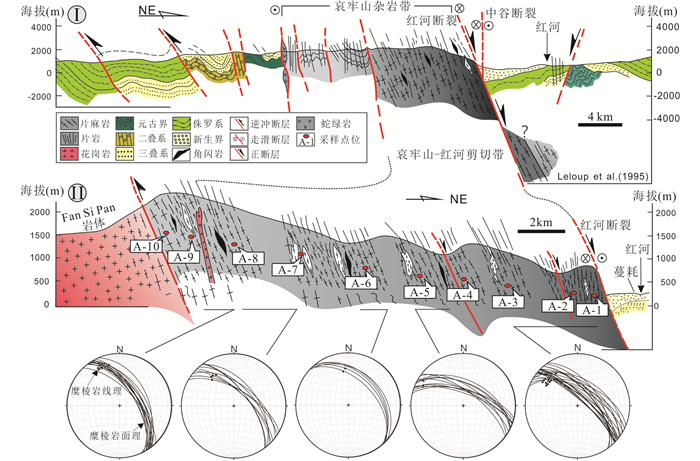
|
图 2 哀牢山-红河剪切带南段嘎洒地区(剖面Ⅰ,据Leloup et al., 1995修改)和蔓耗地区(剖面Ⅱ)构造剖面及采样点位 剖面Ⅰ、Ⅱ位置见图 1;极射赤平投影中大圆代表糜棱岩面理,点为线理;极射赤平投影为等面积、下半球投影 Fig. 2 Structural profile and sampling sites across the Gasa region (Profile Ⅰ, modified after Leloup et al., 1995) and the Manhao region (Profile Ⅱ) of the southern segment of the Ailao Shan-Red River shear zone Profile locations are shown in Fig. 1. The great circles represent mylonitic foliations, and the spots are lineations on all Schmidt net (equal area and lower hemisphere projection) |
利用数字海拔模型(DEM,数据来源于中国地理空间数据云)及垂直条带剖面图分析(制作过程参考Zhang et al., 2011, 本文分析提取哀牢山杂岩带南段等间隔15km的4条地貌海拔剖面,并进行160等分,剖面线横向跨度范围6km),揭示出哀牢山杂岩带南段东侧存在两条线性正断层(图 3a,b)。结合采样位置和DEM图像分析,表明样品A-2与A-3之间、样品A-4和A-5之间存在两条明显的线性正断层,同时根据SPOT卫星图像也可以识别出该正断层(Leloup et al., 2001),该断层近平行于剪切带走向,向东南连续延伸,进入越南境内哀牢山Bat Xat地区(距蔓耗-金平剖面约100km)。

|
图 3 哀牢山-红河剪切带南段蔓耗地区构造地貌分析 (a)蔓耗地区数字海拔模型(DEM)揭示的地貌变化及其断裂位置;(b)垂直条带剖面分析及断层位置(显示了最大、最小和平均地形、主要河流的深切位置和本研究采样位置的投影点) Fig. 3 Tectonic geomorphologic analysis at Manhao region in the southern segment of the Ailao Shan-Red River shear zone (a) geomorphic changes and faults locations based on Digital Elevation Model (DEM) at Manhao region; (b) vertical swath profile analysis and faults locations (these profiles show the max, min and average topography, deep incision of major rivers, and the projected sites of sampling sites in this study) |
裂变径迹法(FT)是低温热年代学的重要方法之一,能够有效揭示上地壳低温热历史演化、造山带隆升剥露过程和地貌演化(Green et al., 1986;Gallagher et al., 1994)。自然界中富U晶体矿物内(主要包括磷灰石、锆石)存在的放射性元素238U通过自发裂变形成两个质量相差不远的碎片,两个裂变碎片彼此相反的方向运动,在晶体内产生一条长达约20μm的辐射损伤,损伤痕迹经化学蚀刻可于光学显微镜下显示,该痕迹即裂变径迹。裂变径迹随着温度升高长度变短、密度减小,直到完全消失,这一现象被称为退火过程。对磷灰石裂变径迹(AFT)而言,退火完全时所处的封闭温度约110℃,部分退火带为60~110℃(Gleadow, 1981)。
AFT最常用的方法是外探测器法(EDM),即通过热中子照射技术,将样品中235U诱发裂变,获得235U的含量或密度,然后根据自然界中235U/238U的比值,计算238U的含量或密度,最后根据标准样品获得的zeta值、标准玻璃形成的校准系统计算样品年龄(Gleadow, 1981;Hurford and Green, 1982;Hurford, 1998),这种方法在近三十年里为地球科学应用提供了大量有效的数据。但外探测器法存在中子热化不充分、中子分布不均一、照射诱发235U的效率问题、照射周期长以及放射性物质难处理等局限性问题。Hasebe et al.(2004)开始尝试使用激光剥蚀-电感耦合等离子体质谱法(LA-ICPMS)直接测定样品中单颗粒的238U浓度,然后结合自发径迹密度初步建立了可替代传统外探测器法的新方法。Pang et al.(2017)通过磷灰石标准样品新方法测试,也建立起系统化的LA-ICPMS磷灰石裂变径迹实验流程。
LA-ICPMS裂变径迹年龄计算原理(Hasebe et al., 2004;Gleadow et al., 2015;Pang et al., 2017):

|
其中:t-裂变径迹年龄,λD-238U的总衰变常数,ρs-自发径迹密度,Cu-LA-ICPMS测试的238U浓度,ξ-校正系数。该实验室中校正系数ξ为1.94×10-3,相当于传统方法的zeta值,计算公式为:

|
其中,M为238U的相对原子质量,取值238g/mol;λf为238U自发裂变常数,取值8.51×10-17yr-1;NA为阿伏伽德罗常数,取值6.02×1023;d是磷灰石的密度,取值3.19g/cm3;Rsp是能够在单颗粒剖光面上观测到的自发径迹的计数因子,通常取平均自发裂变径迹长度的一半,即7.5×10-4cm;k是实验检测效率,通常值取1。裂变径迹单颗粒年龄误差(σ)的计算公式为:

|
其中Ns是自发径迹总量,σu是测量238U浓度的不确定度。
3.2 测试流程样品利用传统方法进行粗选、磁悬浮、重液分选等标准流程分离出所需要的磷灰石单颗粒矿物(使每件样品超过2000个颗粒)。磷灰石裂变径迹观测在中国地震局地质研究所地震动力学国家重点实验室测试完成。使用环氧树脂将磷灰石矿物颗粒固定于树脂载玻片之上,制成薄片,利用抛光机研磨抛光,使磷灰石颗粒内表面最大化出露,然后在21℃室温条件下将薄片放置于5.5mol的HNO3溶液中蚀刻20s,使磷灰石切面上的自发径迹显露。为了准确测量实验样品自发径迹密度和长度等定量数据,提前使用澳大利亚AUTOSCAN裂变径迹测试系统对磷灰石标样(Durango和Fish Canyon Tuff)进行自发径迹密度和诱发径迹密度校准测试,如若测出的数据经外探测器法年龄计算公式得出的zeta值处于磷灰石标样的合理范围之内,方可测试实验样品。然后,使用AUTOSCAN系统显微镜,挑选出每件样品颗粒大小合适(一般大于80μm)、径迹分布均匀、表面干净的单颗粒磷灰石进行自发径迹数量、计数面积、围限径迹长度(平行于切面的径迹长度)以及对应Dpar值(单偏光下平行于C轴、与颗粒切面相交的裂变径迹的最大直径)的测量与计算,同时记录对应单颗粒径迹的统计区域。每件样品需至少测试20个以上有效单颗粒磷灰石的自发径迹数量和面积。最后,采用Resolution M50-LR型ArF准分子激光剥蚀系统(LA)和Agilent 7900型四极杆电感耦合等离子体质谱仪(Q-ICPMS)联机对上述单颗粒磷灰石裂变径迹记录区进行238U浓度微区测试。样品测试序列采用双标样法和内插法,即每测定6个样品点位后测定两个标准玻璃NIST612和两个Durango标样,双标样法可以对仪器的工作状态进行监控,而内插法便于对仪器灵敏度漂移、元素分馏进行校正(李朝鹏等,2019)。LA-ICPMS实验数据处理是采用ICPMSDataCal11.4程序,以43Ca内标准进行简化处理,得到单颗粒磷灰石微区的238U浓度(Liu et al., 2008)。上述LA-ICPMS实验工作参数见表 1。
|
|
表 1 本次研究磷灰石LA-ICPMS测试的工作参数 Table 1 Working parameters of apatite LA-ICPMS test in this study |
磷灰石裂变径迹年龄数据见表 2,采用RadialPlotter软件分析,获取样品中值年龄和单颗粒年龄放射图(Vermeesch, 2009),并制作年龄分布直方图(图 4)。年龄数据分析示意结果见图 4、图 5和图 6。当磷灰石样品年龄通过泊松分布检验概率(P(χ2)>5%)时,表明样品单颗粒年龄属于同一组分,未通过时属于混合年龄(Galbraith, 1981)。本次实验分析中,样品A-1、A-2、A-3、A-4、A-6和A-10的单颗粒年龄数据未通过P(χ2)检验,但样品的围限径迹长度分布普遍呈现为短而窄的单峰式特征(图 6),峰值均位于13~15μm之间,其中样品A-1和A-2具有略宽的负偏特征(图 6),所有样品总体表现出未扰动基岩类型(Gleadow et al., 1986),据此推测样品可能是经历了单调的冷却过程(Ventura and Lisker, 2003);LA-ICPMS测量时,238U浓度微区测试结果可能不均匀导致磷灰石单颗粒年龄偏分散,也可能造成P(χ2)检验这一标准不再适用(Hasebe et al., 2004;Pang et al., 2017)。
|
|
表 2 LA-ICPMS磷灰石裂变径迹分析结果 Table 2 LA-ICPMS apatite fission track data |
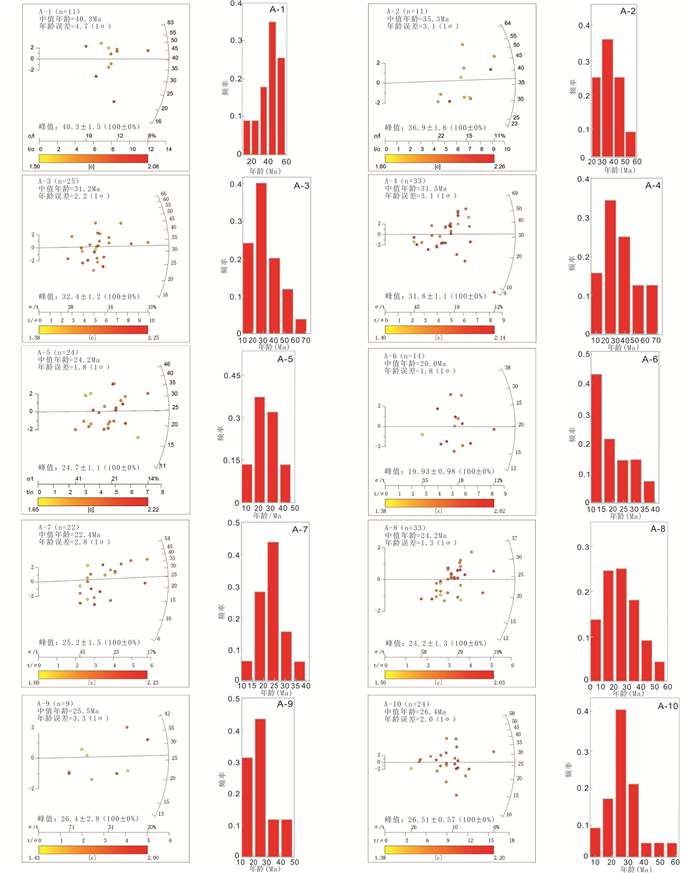
|
图 4 样品单颗粒年龄放射图(左)和年龄分布直方图(右) Fig. 4 Radial plots (left) and histograms (right) of single grain age |
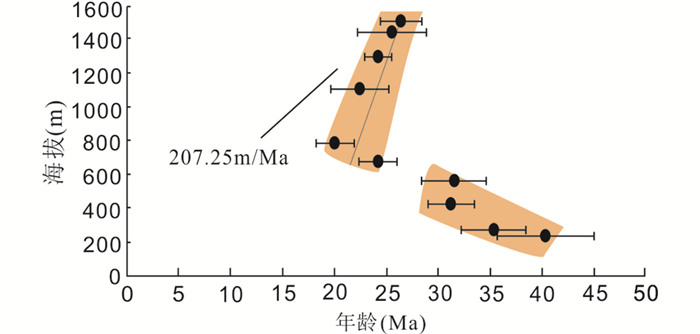
|
图 5 哀牢山-红河剪切带南段蔓耗-金平剖面磷灰石裂变径迹年龄-海拔分析 Fig. 5 Apatite fission track ages-elevation analysis along the Manhao-Jinping profile in the southern segment of the Ailao Shan-Red River shear zone |
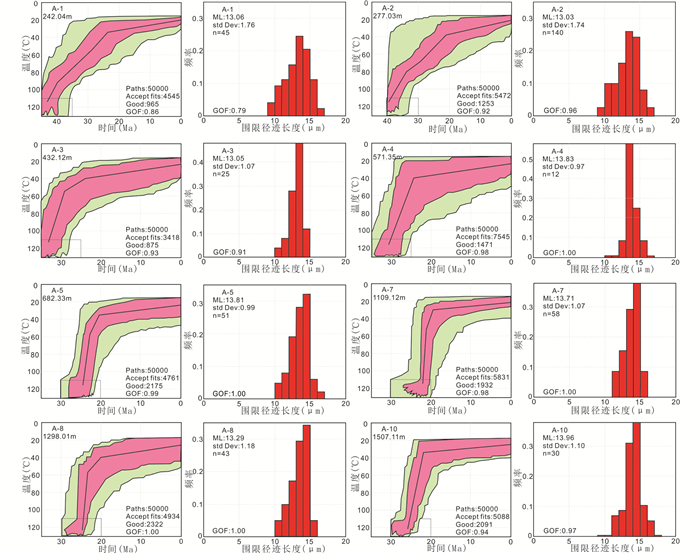
|
图 6 哀牢山-红河剪切带南段蔓耗-金平剖面8件样品HeFTy热史反演模拟结果(左)和径迹长度分布直方图(右) Fig. 6 HeFTy thermal history inverse model results (left) and histograms (right) of fission track lengths from the eight samples of the Manhao-Jinping profile in the southern segment of the Ailao Shan-Red River shear zone |
样品A-1和A-2处于剖面最东侧,均采自片麻岩内,所测中值年龄分别是40.3±4.7Ma和35.3±3.1Ma,年龄分布直方图中峰值分别为50~40Ma和40~30Ma(图 4),围限径迹长度分布特征相似,呈单峰式,表现为略宽的负偏形态,峰值13~14μm(图 6),平均围限径迹长度为13.03~13.06μm,变化小,但标准偏差稍大,在1.74~1.76μm之间,这表明样品A-1和A-2的磷灰石裂变径迹产生后可能较长时间处于部分退火带,故径迹长度稍短(Gleadow et al., 1986)。样品A-3和A-4,中值年龄分别是31.2±2.2Ma和31.5±3.1Ma,单矿物年龄峰值均位于20~33Ma,分布较为集中(图 4)。因符合实验测试要求的单矿物颗粒较少,故围限径迹长度数量偏少。这两个样品围限径迹长度分布呈短而窄的单峰式特征,平均围限径迹长度分别为13.05μm和13.83μm,集中于13~14μm,且标准偏差较小,处于0.97~1.07μm之间,表明样品可能在磷灰石部分退火带所处时间较短(Gleadow et al., 1986)。
样品A-5至A-10采自糜棱岩化的片麻岩内,所测中值年龄分布于26.4±2.0Ma和20.0±1.8Ma之间,所有样品单颗粒年龄分布均呈现单峰式结构(图 4)。除样品A-6和A-9因磷灰石单颗粒少、径迹少等因素无法测出围限径迹长度外,其余样品围限径迹长度均呈现短而窄的单峰式特征(图 6),峰值为14~15μm,平均径迹长度在13.29~13.96μm之间,标准偏差较小,处于0.99~1.18μm,暗示样品通过部分退火带的时间可能很短(Gleadow et al., 1986)。
总体而言,蔓耗-金平采样剖面,样品磷灰石裂变径迹年龄和采样点海拔呈两阶段特征(图 5)。40~26Ma期间,海拔小于570m的样品A-1至A-4年龄与海拔表现为负相关,斜率较平缓;在26Ma之后,海拔大于680m的样品A-5至A-10年龄与海拔呈正相关,且斜率较陡,约207.25m/Myr,这一阶段共持续了4~6Ma,可能指示快速冷却。
4.2 热反演模拟结果为进一步限定研究区低温热历史演化,本次应用磷灰石裂变径迹单颗粒年龄、Dpar值、围限径迹长度等实验数据进行热史反演模拟(图 6)(Green et al., 1989;Ketcham, 2005;Ketcham et al., 2007;Okay et al., 2010)。模拟采用Ketcham et al.(2007)的多元退火模型,利用HeFTy软件(1.9.1版本)实现反演结果。模拟受如下条件约束:(1)初始径迹长度是16.3μm(Gleadow et al., 1986);(2)反演模拟起始时间根据样品单颗粒年龄而定(Ketcham, 2005);(3)模拟起始温度不小于磷灰石处于完全退火状态时的温度(即封闭温度),以110~130℃为准(图 6黑色小框所示);(4)地表温度以现今地表温度作为参考,即20±5℃(Wang et al., 2016b);(4)AFT部分退火带范围为60~110℃(Gleadow et al., 1986);(5)运动学参数设置为Dpar(Ketcham, 2005);(6)评估值(年龄GOF、径迹长度GOF)用来检验模拟结果是否可靠,一般认为当年龄GOF和径迹长度GOF大于0.5时模拟结果是理想的(袁万明等,2007)。热反演模拟结果由三个拟合区组成,即可接受的拟合区域(图 6中浅红色部分)、良好的拟合区域(图 6中浅绿色部分)和最佳拟合路径(图 6中浅绿色区域内黑色实线)(Ketcham, 2005)。为了呈现更加直观的模拟结果,每件样品通过多次模拟选取最佳结果,所有模拟均设置为50000条路径。
8件样品热反演结果显示,所有样品在晚始新世-早中新世(40~20Ma)经历了较为快速的冷却过程,但不同样品反演结果略有差异。剪切带最东部的样品A-1和A-2热历史比较类似,主要表现为经历部分退火带时间较长(历时14~16Ma),模拟结果可划分为两个部分,较快速的冷却大约开始于40Ma,并于24~21Ma停止,降温幅度约75℃,冷却速率为4.17℃/Myr;随后以缓慢冷却过程,降温约15℃,冷却速率为0.63~0.71℃/Myr。而样品A-3和A-4模拟结果类似,样品所处磷灰石部分退火带时间较短(5~6Ma);模拟结果显示在32~24Ma经历一次快速冷却事件,平均冷却速率为7.78℃/Myr,而自24Ma至今,发生慢速冷却,速率为0.83℃/Myr。西侧4件样品A-5、A-7、A-8和A-10模拟结果相似,每件样品所处磷灰石部分退火带时间很短,约1~3Ma,模拟结果可大致分为两个阶段:26~20Ma表现出一次快速冷却,速率为23.30~35.00℃/Myr,20Ma至今表现出慢速冷却,速率0.47~0.83℃/Myr,并持续剥露到达地表(图 6)。
5 讨论在横穿哀牢山剪切带南段的蔓耗-金平剖面,磷灰石裂变径迹年龄-海拔显示有规律变化,可以分为两个变化趋势(图 5)。
在低海拔区(242~571m)的4件样品A-1、A-2、A-3和A-4的裂变径迹年龄自东向西依次为40.3Ma、35.3Ma、31.2Ma、31.5Ma,与地形海拔呈现负相关性(图 5),在地貌特征图上显示样品A-1与A-2,以及样品A-3与A-4之间出现明显的地貌低谷,且低谷NW-SE向延伸超过100km,走向近平行于哀牢山剪切带(图 3a, b),暗示这4个自东向西依次变年轻的裂变径迹年龄可能与正断层活动有关。一般情况,在造山带内部随着岩石隆升,岩石内部磷灰石达到封闭温度后开始计时(Gleadow et al., 1986;Gallagher et al., 1994),岩石样品磷灰石裂变径迹年龄呈现随海拔增高年龄增大的趋势(Benjamin et al., 1987;Braun, 2002),但样品A-1至A-4的年龄-海拔关系趋势恰恰相反,原因可以归结于研究区东侧正断层错断的影响,使得山前较老的磷灰石裂变径迹年龄得以保存。Viola and Anczkiewicz(2008)对越南北部哀牢山老街剖面(蔓耗-金平剖面以南约100km)的磷灰石裂变径迹数据分析也显示出,剪切带东侧低海拔100m样品(样品99/48)年龄偏老,为35±7Ma,而逐渐向西的高海拔区样品(样品99/40(海拔1200m)、样品99/41(海拔1400m))年龄趋于变年轻,分别为21±4Ma和28±7Ma。结合样品A-1至A-4磷灰石反演结果,表明构造带经历的部分退火带时间较长,约4~16Ma。据此本文解释认为,在40~26Ma期间,哀牢山剪切带南段可能以伸展走滑剪切变形为主,导致剪切带内部变质岩石沿伸展作用的垂直分量垂向运动而抬升,在伸展剪切运动中,磷灰石部分退火带发生错断,导致上盘岩片的磷灰石裂变径迹年龄呈现“老龄化”(即断层上盘样品A-1、A-2年龄相对下盘样品A-3、A-4的年龄偏大),下盘高海拔岩片的年龄“年轻化”的特征(图 7e)。这一早期的伸展走滑事件在区域上也有响应:在空间上沿哀牢山杂岩带分布的Fan Si Pan岩体在地球化学上呈高钾碱性特征,构造上表现为前-同剪切(Zhang and Schärer, 1999),锆石U-Pb年龄集中在38~28Ma(Zhang and Schärer, 1999;Liang et al., 2007),黑云母年龄为34~32Ma(Leloup et al., 2001),锆石、磷灰石裂变径迹年龄集中于40~26Ma(Anczkiewicz et al., 2007;Viola and Anczkiewicz, 2008),同时Po Sen等高钾碱性岩体也具有类似特征(Leloup et al., 2001);藏东南地区众多断层活动在新生代表现为正断性质或兼具正断倾滑分量的走滑断层特征,如红河断裂、鲜水河断裂、建水断裂等(Wang and Burchfiel, 1997;徐锡伟等,2003;Wang et al., 2016b);中国南海地区磁异常分析表明南海初始扩张发生于34~32Ma(Briaris et al., 1993)。上述地质事件可能共同暗示哀牢山地区在晚始新世-渐新世处于区域性伸展的构造环境(Leloup et al., 2001;Anczkiewicz et al., 2007;Liu et al., 2007, 2015;Viola and Anczkiewicz, 2008)。

|
图 7 哀牢山-红河剪切带南段晚新生代以来构造剥露模式 (a)“拉链”模式解释的哀牢山-红河剪切带构造变形与剥露机制模型(据Leloup et al., 2001修改);(b-d)26Ma之前,哀牢山-红河剪切带南段左旋走滑伸展变形体制及变质岩剥露机制;(e)26Ma之后,哀牢山-红河剪切带以简单剪切左旋走滑变形为主的剥露过程 Fig. 7 The model of tectonic exhumation of the southern segment of the Ailao Shan-Red River shear zone during the Late Cenozoic (a) the zipper model for tectonic deformation and exhumation mechanism of the Ailao Shan-Red River shear zone (modified after Leloup et al., 2001); (b-d) sinistral transtensional deformation and its exhumation along the southern segment of the shear zone before 26Ma; (e) simple shearing deformation with left-lateral strike-slip shearing along the Ailao Shan-Red River shear zone after 26Ma |
而样品A-5以西的6个采样点所获取的裂变径迹年龄集中在26~20Ma之间,自东向西随海拔呈现正相关性,裂变径迹年龄-海拔分布图上显示为陡斜率。采自哀牢山杂岩带内的这6件样品可以被视为垂直剖面分布,主要原因如下:(1)这6个采样点岩性均为糜棱岩化片麻岩,水平距离小于9km;(2)磷灰石裂变径迹主要揭示近地表(< 3km)剥露过程(Gleadow et al., 1986;Braun, 2002),采样区数字海拔模型显示的地貌特征和野外未发现脆性断层形迹;(3)磷灰石热史反演模拟结果显示4件样品(A-5、A-7、A-8、A-10)具有类似的低温热演化史,即26~20Ma时期经历快速剥露过程,而后长期处于稳定的慢速剥露。这一时期哀牢山杂岩带的快速冷却剥露与众多地质证据吻合:在哀牢山杂岩带内发育大量的钙碱性花岗质岩墙、岩脉,大都表现为同剪切特征,不对称长石碎斑、S-C组构等左旋剪切特征大量存在,岩脉内锆石U-Pb、云母40Ar/39Ar、斜长石40Ar/39Ar年龄主要集中于27~21Ma(Leloup et al., 1995;Searle, 2006;Searle et al., 2010;Cao et al., 2011;Liu et al., 2015;Wang et al., 2016b),解释为与左旋剪切高度相关的产物;点苍山杂岩带片麻岩内角闪石40Ar/39Ar、云母40Ar/39Ar年龄揭示了28~21Ma的快速冷却事件(Leloup et al., 2001;Cao et al., 2011);哀牢山杂岩带北-中段片麻岩的云母40Ar/39Ar、长石40Ar/39Ar年龄同样表明27~20Ma的快速冷却过程(Harrison et al., 1996;Leloup et al., 2001;Chen et al., 2015);大象山杂岩带内片麻岩云母40Ar/39Ar、长石40Ar/39Ar、磷灰石裂变径迹年龄也共同暗示了28~20Ma的快速冷却事件(Maluski et al., 2001;Viola and Anczkiewicz, 2008)。
综合上述分析,晚渐新世-早中新世时期哀牢山-红河剪切带发生强烈的左旋韧性剪切运动,导致剪切带内各类片麻岩快速抬升冷却至110℃左右(Leloup et al., 1995, 2001;Chen et al., 2015;Liu et al., 2015)。因此,本文认为晚渐新世(~26Ma),哀牢山-红河剪切带及其周缘地区发生了强烈的构造体制转换,从走滑伸展变形转变为单剪变形(图 7b-e)。
从青藏高原东缘向滇西地区,许多区域地质证据均暗示晚渐新世的构造体制转换:(1)藏东南区域性高钾碱性岩浆活动在晚始新世-早渐新世较为频繁,晚渐新世开始以钙碱性岩浆活动为主(Zhang and Schärer, 1999;Liang et al., 2007);(2)中国南海海盆于渐新世的扩张在~26Ma开始由南北向转变为北东-南西向(Briais et al., 1993);(3)南海海盆陆源碎屑沉积物内稀土元素和Nd同位素地球化学分析表明,在28~26Ma时期,元素含量存在明显异常(Li et al., 2003;邵磊等,2004);(4)同时期(28~26Ma)南海地震剖面和古生物地层数据揭示在晚渐新世,南海出现短暂的沉积间断,南海在这一时期处于极不稳定的构造环境(Li et al., 2003, 2005;邵磊等,2004)。结合上述低温年代学数据和该区域已发表的构造观测、年龄数据结果,本文认为Harrison et al.(1996)和Leloup et al.(2001)所提出的“拉链”构造模式可以较为合理解释哀牢山-红河韧性走滑剪切带的构造演化(图 7a),该模式认为在印支板块相对于固定的扬子板块顺时针运动时,哀牢山-红河剪切带南段的哀牢山杂岩带受走滑伸展构造体制控制,并导致地壳深部变质杂岩发生垂直运动(图 7b-e),即渐新世-早中新世时期快速冷却剥露事件。本次研究在哀牢山南段所获得的磷灰石裂变径迹年龄厘定出走滑伸展应变发生在约26Ma之前,之后哀牢山杂岩带及东南缘地区转换进入单剪变形阶段(图 7e)。
在研究区以北的嘎洒-元阳地区,即哀牢山杂岩带北-中段,万京林等(1997)报道的磷灰石裂变径迹低温热年代学年龄为10.64~5.61Ma,Li et al.(2014)报道出嘎洒地区磷灰石裂变径迹年龄是8.4~4.6Ma;而在中段的元阳地区,Chen et al.(2015)获取的磷灰石裂变径迹年龄范围为13~8.9Ma,同时在中段南沙和元江地区,Wang et al.(2016b)报道的磷灰石U-Th/He年龄为13~10Ma。这些哀牢山带北段和中段所揭示的低温年年代学数据普遍低于南段年龄(本次研究)。就哀牢山南段以北更广泛地区的低温热年代学数据对比分析发现,它们的低温冷却时间普遍更晚(图 1),如鲜水河-小江断裂以西区域最新一期的快速剥露和河流快速下切普遍发生在中中新世之后(Clark et al., 2005, 2006;向树元等,2007;Stewart and Brug, 2008;Lin et al., 2009;Ouimet et al., 2010;Wang et al., 2016b, 2018;Yang et al., 2016),龙门山地区最新的快速剥露事件发生在中-晚中新世期间(Godard et al., 2009;Ouimet et al., 2010;Wang et al., 2012;Jolivet et al., 2015),高原东南缘大型走滑断裂(如甘孜断裂、鲜水河-小江断裂、嘉黎断裂等)的活动亦发生于中-晚中新世(Clark et al., 2005;Seward and Burg, 2008;Wang et al., 2009)。因此,自高原东缘向哀牢山方向,剥露可能受到渐新世-早中新世左旋剪切运动(走滑伸展变形)和中-晚中新世青藏高原内部中、下地壳物质向东南方向流动的影响。哀牢山-红河剪切带的左旋剪切运动和青藏高原内中、下地壳流变也导致了哀牢山杂岩带的北段和中段出现了显著的两阶段快速冷却历史(图 8所示,北段第一期快速冷却速率>100℃/Myr,第二期快速冷却速率~29℃/Myr;中段第一期快速冷却速率>75℃/Myr,第二期快速冷却速率~25℃/Myr),而南段却呈现单阶段快速冷却过程(图 8所示,南段唯一一次快速冷却速率为>28℃/Myr,与反演模拟结果得出的冷却速率23.30~35.00℃/Myr一致)。因此本文认为哀牢山杂岩带北段和中段所出现的第一期快速冷却作用与南段唯一的冷却事件相对应,相关块体在围绕欧拉极旋转过程中,同时在边界的不同位置产生不同的应力体制和应变方式(图 7a),在哀牢山-红河剪切带的南缘以走滑伸展变形调节块体的旋转,导致哀牢山-红河剪切带内片麻岩冷却年龄自南东向北西逐渐变新(图 8)(Leloup et al., 2001)。在中-晚新世,高原内部中、下地壳物质向东南方向运动可能达到哀牢山-红河剪切带的中段(哀牢山地区),并诱发哀牢山北段和中段最新一期的地壳抬升和剥露过程,但这一构造活动可能并未影响到较远的四川盆地、哀牢山南段及以南地区(图 1)(Maluski et al., 2001;陈小宇等,2016)。
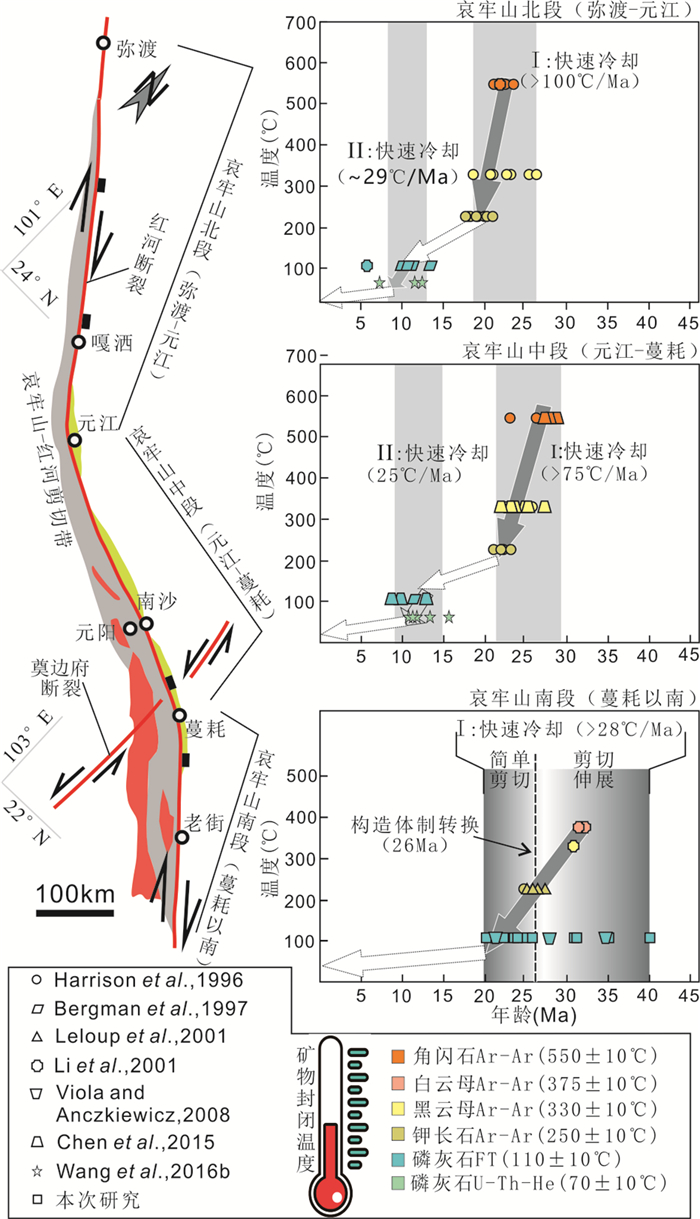
|
图 8 哀牢山杂岩带的北段(弥渡-元江)、中段(元江-蔓耗)和南段(蔓耗以南)冷却路径对比显示的哀牢山北-中段两期快速冷却事件和哀牢山南段一期快速冷却事件 低温热年代学数据来源:Harrison et al., 1996;Bergman et al., 1997;Leloup et al., 2001;Li et al., 2001;Viola and Anczkiewicz, 2008;Chen et al., 2015;Wang et al., 2016b Fig. 8 Various cooling paths in the northern segment (Midu-Yuanjiang), the middle segment (Yuanjiang-Manhao) and the southern segment (Manhao) of Ailao Shan shear zone showing the two periods of rapid cooling in the northern and middle segments of the Ailao Shan range, and the one period of rapid cooling in the southern segment of the range Sources of low temperature chronological data: Harrison et al., 1996; Bergman et al., 1997; Leloup et al., 2001; Li et al., 2001; Viola and Anczkiewicz, 2008; Chen et al., 2015; Wang et al., 2016b |
本次研究采用LA-ICPMS磷灰石裂变径迹方法分析了青藏高原东南缘大型韧性走滑剪切带哀牢山-红河剪切带的热演化历史,分析结果表明:
(1) 该剪切带南段在40~20Ma期间发生快速剥露,自20Ma之后,剪切带南段处于稳定慢速剥露过程。其中,样品A-1至A-4揭示出该带在40~26Ma期间快速冷却速率为4.17~7.78℃/Myr;样品A-5至A-10表明26~20Ma时期快速冷却速率为23.30~35.00℃/Myr。20Ma至今为慢速冷却,速率0.47~0.83℃/Myr。
(2) 哀牢山剪切带在26Ma发生了强烈的构造体制转换,由左旋走滑伸展的构造体制,转变为简单剪切走滑体制。
(3) 哀牢山杂岩带各段的冷却路径对比,表明北-中段在新生代存在两阶段快速冷却作用,而南段为单次快速冷却作用。结合青藏高原东南缘低温热年代学数据和构造变形,揭示自中-晚中新世,青藏高原中、下地壳物质可能向东南缘扩展,并已到达哀牢山中段,同时诱发哀牢山杂岩带以北广大地区的抬升和快速冷却。
致谢 衷心感谢中国地震局地质研究所庞建章博士、王英工程师在LA-ICPMS裂变径迹实验测试与分析过程中的悉心指导;特别感谢中山大学地球科学与工程学院郑文俊教授在文章讨论和数据解释过程中的建设性建议;同时真挚的感谢北京大学地球与空间科学学院张志诚教授对于数据分析和解释的耐心指导;最后由衷感谢二位审稿人和编辑的细心审阅和宝贵性的意见与建议。
Akciz S, Burchfiel BC, Crowley JL, Yin JY and Chen LZ. 2008. Geometry, kinematics, and regional significance of the Chong Shan shear zone, Eastern Himalayan Syntaxis, Yunnan, China. Geosphere, 4(1): 292-314 DOI:10.1130/GES00111.1 |
Anczkiewicz R, Viola G, Müntener O, Thirlwall MF, Villa IM and Quong NQ. 2007. Structure and shearing conditions in the Day Nui Con Voi massif: Implications for the evolution of the Red River shear zone in northern Vietnam. Tectonics, 26(2): TC2002 DOI:10.1029/2006TC001972 |
Benjamin MT, Johnson NM and Naeser CW. 1987. Recent rapid uplift in the Bolivian Andes: Evidence from fission-track dating. Geology, 15(7): 680-683 DOI:10.1130/0091-7613(1987)15<680:RRUITB>2.0.CO;2 |
Bergman SC, Leloup PH, Tapponnier P, Schärer U and O'Sullivan P. 1997. Apatite fission track thermal history of the Ailao Shan-Red River shear zone, China. Strasbourg, France: European Union of Geoscience
|
Braun J. 2002. Quantifying the effect of recent relief changes on age-elevation relationships. Earth and Planetary Science Letters, 200(3-4): 331-343 DOI:10.1016/S0012-821X(02)00638-6 |
Briais A, Patriat P and Tapponnier P. 1993. Updated interpretation of magnetic anomalies and seafloor spreading stages in the South China Sea: Implications for the Tertiary tectonics of Southeast Asia. Journal of Geophysical Research, 98(B4): 6299-6328 DOI:10.1029/92JB02280 |
Burchfiel BC and Wang E. 2003. Northwest-trending, Middle Cenozoic, left-lateral faults in southern Yunnan, China, and their tectonic significance. Journal of Structural Geology, 25(5): 781-792 DOI:10.1016/S0191-8141(02)00065-2 |
Cao SY, Neubauer F, Liu JL, Genser J and Leiss B. 2011. Exhumation of the Diancang Shan metamorphic complex along the Ailao Shan-Red River belt, southwestern Yunnan, China: Evidence from 40Ar/39Ar thermochronology. Journal of Asian Earth Sciences, 42(3): 525-550 DOI:10.1016/j.jseaes.2011.04.017 |
Chen XY, Liu JL, Tang Y, Song ZJ and Cao SY. 2015. Contrasting exhumation histories along a crustal-scale strike-slip fault zone: the Eocene to Miocene Ailao Shan-Red River shear zone in southeastern Tibet. Journal of Asian Earth Sciences, 114: 174-187 DOI:10.1016/j.jseaes.2015.05.020 |
Chen XY, Liu JL and Weng ST. 2016. Deformation characteristics and Cenozoic exhumation of the Yao Shan complex evidenced by apatite fission track thermochronology. Acta Petrologica Sinica, 32(8): 2303-2316 (in Chinese with English abstract) |
Clark MK and Royden LH. 2000. Topographic ooze: Building the eastern margin of Tibet by lower crustal flow. Geology, 28(8): 703-706 DOI:10.1130/0091-7613(2000)28<703:TOBTEM>2.0.CO;2 |
Clark MK, House MA, Royden LH, Whipple KX, Burchfiel BC, Zhang X and Tang W. 2005. Late Cenozoic uplift of southeastern Tibet. Geology, 33(6): 525-528 DOI:10.1130/G21265.1 |
Clark MK, Royden LH, Whipple KX, Burchfiel BC, Zhang X and Tang W. 2006. Use of a regional, relict landscape to measure vertical deformation of the eastern Tibetan Plateau. Journal of Geophysical Research: Earth Surface, 111(F3): F03002 |
Deng B, Liu SG, Enkelmann E, Li ZW, Ehlers TA and Jansa L. 2015. Late Miocene accelerated exhumation of the Daliang Mountains, southeastern margin of the Tibetan Plateau. International Journal of Earth Sciences, 104(4): 1061-1081 DOI:10.1007/s00531-014-1129-z |
Deng B, Liu SG, Jiang L, Zhao GP, Huang R, Li ZW, Li JX and Jansa L. 2018. Tectonic uplift of the Xichang Basin (SE Tibetan Plateau) revealed by structural geology and thermochronology data. Basin Research, 30(1): 75-96 DOI:10.1111/bre.12243 |
Faure M, Lepvrier C, Van Nguyen V, Van Vu T and Chen ZC. 2014. The south China block-Indochina collision: Where, when, and how?. Journal of Asian Earth Sciences, 79: 260-274 DOI:10.1016/j.jseaes.2013.09.022 |
Galbraith RF. 1981. On statistical models for fission track counts. Journal of the International Association for Mathematical Geology, 13(6): 471-478 DOI:10.1007/BF01034498 |
Gallagher K, Hawkesworth CJ and Mantovani MSM. 1994. The denudation history of the onshore continental margin of SE Brazil inferred from apatite fission track data. Journal of Geophysical Research, 99(B9): 18117-18145 DOI:10.1029/94JB00661 |
Ge YK, Jing LZ, Zhang JY, Wang W, Tian YT, Fox M, Zeng LS, Shen XM, Wang H, Su Z and Xie KJ. 2020. Spatio-temporal variation in rock exhumation linked to large-scale shear zones in the southeastern Tibetan Plateau. Science China (Earth Sciences), 63(4): 512-532 DOI:10.1007/s11430-019-9567-y |
Gleadow AJW. 1981.. Fission-track dating methods: What are the real alternatives?. Nuclear Tracks, 5(1-2): 3-14 DOI:10.1016/0191-278X(81)90021-4 |
Gleadow AJW, Duddy IR, Green PF and Lovering JF. 1986. Confined fission track lengths in apatite: A diagnostic tool for thermal history analysis. Contributions to Mineralogy Petrology, 94(4): 405-415 DOI:10.1007/BF00376334 |
Gleadow AJW, Harrison M, Kohn BP, Lugo-Zazueta R and Phillips D. 2015. The Fish Canyon Tuff: A new look at an old low-temperature thermochronology standard. Earth and Planetary Science Letters, 424: 95-108 DOI:10.1016/j.epsl.2015.05.003 |
Godard V, Pik R, Lavé J, Cattin R, Tibari B, de Sigoyer J, Pubellier M and Zhu J. 2009. Late Cenozoic evolution of the central Longmen Shan, eastern Tibet: Insight from (U-Th)/He thermochronometry. Tectonics, 28(5): TC5009 DOI:10.1029/2008TC002407 |
Green PF, Duddy IR, Gleadow AJW, Tingate PR and Laslett GM. 1986. Thermal annealing of fission tracks in apatite: 1. A qualitative description. Chemical Geology: Isotope Geoscience Section, 59: 237-253 DOI:10.1016/0168-9622(86)90074-6 |
Green PF, Duddy IR, Laslett GM, Hegarty KA, Gleadow AJW and Lovering JF. 1989. Thermal annealing of fission tracks in apatite: 4. Quantitative modelling techniques and extension to geological timescales. Chemical Geology: Isotope Geoscience Section, 79(2): 155-182 |
Harrison TM, Chen WJ, Leloup PH, Ryerson FJ and Tapponnier P. 1992. An Early Miocene transition in deformation regime within the Red River fault zone, Yunnnan, and its significance for Indo-Asian tectonics. Journal of Geophysical Research, 97(B5): 7159-7182 DOI:10.1029/92JB00109 |
Harrison TM, Leloup PH, Ryerson FJ, Tapponnier P, Lacassin R and Chen WJ. 1996. Diachronous initiation of transtension along the Ailao Shan-Red River Shear zone, Yunnan and Vietnam. World and Regional Geology, 1(8): 208-226 |
Hasebe N, Barbarand J, Jarvis K, Carter A and Hurford AJ. 2004. Apatite fission-track chronometry using laser ablation ICP-MS. Chemical Geology, 207(3-4): 135-145 DOI:10.1016/j.chemgeo.2004.01.007 |
Huang K and Opdyke ND. 1993. Paleomagnetic results from Cretaceous and Jurassic rocks of South and Southwest Yunnan: Evidence for large clockwise rotations in the Indochina and Shan-Thai-Malay terranes. Earth and Planetary Science Letters, 117(3-4): 507-524 DOI:10.1016/0012-821X(93)90100-N |
Hurford AJ and Green PF. 1982. A users' guide to fission track dating calibration. Earth and Planetary Science Letters, 59(2): 343-354 |
Hurford AJ. 1998. Zeta: The ultimate solution to fission-track analysis calibration or just an interim measure? In: van den Haute P and de Corte F (eds.). Advances in Fission-Track Geochronology. Netherlands: Kluwer Academic Publishing, 19-32
|
Jolivet L, Beyssac O, Goffé B, Avigad D, Lepvrier C, Maluski H and Thang TT. 2001. Oligo-Miocene midcrustal subhorizontal shear zone in Indochina. Tectonics, 20(1): 46-57 DOI:10.1029/2000TC900021 |
Jolivet M, Roger F, Xu ZQ, Paquette JK and Cao H. 2015. Mesozoic-Cenozoic evolution of the Danba dome (Songpan Garzê, East Tibet) as inferred from LA-ICPMS U-Pb and fission-track data. Journal of Asian Earth Sciences, 102: 180-204 DOI:10.1016/j.jseaes.2015.02.009 |
Ketcham RA. 2005. Forward and inverse modeling of low-temperature thermochronometry data. Reviews in Mineralogy and Geochemistry, 58(1): 275-314 DOI:10.2138/rmg.2005.58.11 |
Ketcham RA, Carter A, Donelick RA, Barbarand J and Hurford AJ. 2007. Improved measurement of fission-track annealing in apatite using c-axis projection. American Mineralogist, 92(5-6): 789-798 DOI:10.2138/am.2007.2280 |
Lai QZ, Ding L, Wang HW, Yue YH and Cai FL. 2007. Constraining the stepwise migration of the eastern Tibetan Plateau margin by apatite fission track thermochronology. Science in China (Series D), 50(2): 172-183 DOI:10.1007/s11430-007-2048-7 |
Leloup PH and Kienast JR. 1993. High-temperature metamorphism in a major strike-slip shear zone: The Ailao Shan-Red River, People's Republic of China. Earth and Planetary Science Letters, 118(1-4): 213-234 DOI:10.1016/0012-821X(93)90169-A |
Leloup PH, Lacassin R, Tapponnier P, Schärer U, Zhong DL, Liu XH, Zhang LS, Ji SC and Trinh PT. 1995. The Ailao Shan-Red River shear zone (Yunnan, China), Tertiary transform boundary of Indochina. Tectonophysics, 251(1-4): 3-10, 13-84 DOI:10.1016/0040-1951(95)00070-4 |
Leloup PH, Arnaud N, Lacassin R, Kienast JR, Harrison TM, Phan Trong TT, Replumaz A and Tapponnier P. 2001. New constraints on the structure, thermochronology, and timing of the Ailao Shan-Red River shear zone, SE Asia. Journal of Geophysical Research, 106(B4): 6683-6732 DOI:10.1029/2000JB900322 |
Li BL, Wang DD and Ji JQ. 2014. Structure, timing, and mechanism of the Pliocene and Late Miocene uplift process of the Ailao Shan-Diancang Shan, SE Tibet, China. Acta Geologica Sinica, 88(4): 1084-1101 DOI:10.1111/1755-6724.12275 |
Li CP, Zheng DW, Wang Y, Pang JZ, Xiao L and Li YJ. 2019. Precise and accurate in situ U-Pb dating of zircon by LA-ICP-MS. Seismology and Geology, 41(1): 237-249 (in Chinese with English abstract) |
Li Q, Chen WJ, Wan JL and Li DM. 2001. New evidence of tectonic uplift and transform of movement style along Ailao Shan-Red River shear zone. Science in China (Series D), 44(2): 124-132 DOI:10.1007/BF02879655 |
Li QY, Jian ZM and Su X. 2005. Late Oligocene rapid transformations in the South China Sea. Marine Micropaleontology, 54(1-2): 5-25 DOI:10.1016/j.marmicro.2004.09.008 |
Li SH, Yang ZY, Deng CL, He HY, Qin HF, Sun L, Yuan J, van Hinsbergen DJJ, Krijgsman W, Dekkers MJ, Pan YX and Zhu RX. 2017. Clockwise rotations recorded in redbeds from the Jinggu Basin of northwestern Indochina. GSA Bulletin, 129(9-10): 1100-1122 |
Li SH, van Hinsbergen DJJ, Deng CL, Advokaat EL and Zhu RX. 2018. Paleomagnetic constraints from the Baoshan area on the deformation of the Qiangtang-Sibumasu Terrane around the eastern Himalayan Syntaxis. Journal of Geophysical Research: Solid Earth, 123(2): 977-997 DOI:10.1002/2017JB015112 |
Li XH, Wei GJ, Shao L, Liu Y, Liang XR, Jian ZM, Su M and Wang PX. 2003. Geochemical and Nd isotopic variations in sediments of the South China Sea: A response to Cenozoic tectonism in SE Asia. Earth and Planetary Science Letters, 211(3-4): 207-220 DOI:10.1016/S0012-821X(03)00229-2 |
Liang HY, Campbell IH, Allen CM, Sun WD, Yu HX, Xie YW and Zhang YQ. 2007. The age of the potassic alkaline igneous rocks along the Ailao Shan-Red river shear zone: Implications for the onset age of left-lateral shearing. Journal of Geology, 115(2): 231-242 DOI:10.1086/510801 |
Lin TH, Lo CH, Chung SL, Hsu FJ, Yeh MW, Lee TY, Ji JQ, Wang YZ and Liu DY. 2009. 40Ar/39Ar dating of the Jiali and Gaoligong shear zones: Implications for crustal deformation around the Eastern Himalayan Syntaxis. Journal of Asian Earth Sciences, 34(5): 674-685 DOI:10.1016/j.jseaes.2008.10.009 |
Liu JL, Cao SY, Zhai YF, Song ZJ, Wang AJ, Xiu QY, Cao DH, Gao L and Guan Y. 2007. Rotation of crustal blocks as an explanation of Oligo-Miocene extension in Southeastern Tibet: Evidenced by the Diancangshan and nearby metamorphic core complexes. Earth Science Frontiers, 14(4): 40-48 DOI:10.1016/S1872-5791(07)60028-1 |
Liu JL, Tang Y, Song ZJ, Dung TM, Zhai YF, Wu WB and Chen W. 2011. The Ailaoshan belt in western Yunnan: tectonic framework and tectonic evolution. Journal of Jilin University (Earth Science Edition), 41(5): 1285-1303 (in Chinese with English abstract) |
Liu JL, Chen XY, Wu WB, Tang Y, Tran MD, Nguyen QL, Zhang ZC and Zhao ZD. 2015. New tectono-geochronological constraints on timing of shearing along the Ailao Shan-Red River shear zone: Implications for genesis of Ailao Shan gold mineralization. Journal of Asian Earth Sciences, 103: 70-86 DOI:10.1016/j.jseaes.2014.11.006 |
Liu SG, Ma YS, Sun W, Cai XY, Liu S, Huang WM, Xu GS, Yong ZQ, Wang GZ, Wang H and Pan CL. 2008. Studying on the difference of Sinian natural gas pools between Weiyuan gas field and Ziyang gas-brone area, Sichuan Basin. Acta Geologica Sinica, 82(3): 328-337 (in Chinese with English abstract) DOI:10.1007/s11442-008-0201-7 |
Liu YS, Hu ZC, Gao S, Günther D, Xu J, Gao CG and Chen HH. 2008. In situ analysis of major and trace elements of anhydrous minerals by LA-ICP-MS without applying an internal standard. Chemical Geology, 257(1): 34-43 |
Maluski H, Lepvrier C, Jolivet L, Carter A, Roques D, Beyssac O, Tang TT, Than ND and Avigad D. 2001. Ar-Ar and fission-track ages in the Song Chay Massif: Early Triassic and Cenozoic tectonics in northern Vietnam. Journal of Asian Earth Sciences, 19(1): 233-248 |
Okay AI, Zattin M and Cavazza W. 2010. Apatite fission-track data for the Miocene Arabia-Eurasia collision. Geology, 38(1): 35-38 |
Ouimet W, Whipple K, Royden L, Reiners P, Hodges K and Pringle M. 2010. Regional incision of the eastern margin of the Tibetan Plateau. Lithosphere, 2(1): 50-63 DOI:10.1130/L57.1 |
Pang JZ, Zheng DW, Ma Y, Wang Y, Wu Y, Wan JL, Yu JX, Li YJ and Wang YZ. 2017. Combined apatite fission-track dating, chlorine and REE content analysis by LA-ICPMS. Science Bulletin, 62(22): 1497-1500 DOI:10.1016/j.scib.2017.10.009 |
Replumaz A, Lacassin R, Tapponnier P and Leloup PH. 2001. Large river offsets and Plio-Quaternary dextral slip rate on the Red River fault (Yunnan, China). Journal of Geophysical Research: Solid Earth, 106(B1): 819-836 DOI:10.1029/2000JB900135 |
Richardson NJ, Densmore AL, Seward D, Fowler A, Wipf M, Ellis MA, Yong L and Zhang Y. 2008. Extraordinary denudation in the Sichuan Basin: Insights from low-temperature thermochronology adjacent to the eastern margin of the Tibetan Plateau. Journal of Geophysical Research, 113(B4): B04409 DOI:10.1029/2006JB004739 |
Roger F, Calassou S, Lancelot J, Malavieille J, Mattauer M, Xu ZQ, Hao ZW and Hou LW. 1995. Miocene emplacement and deformation of the Konga Shan granite (Xianshui He fault zone, West Sichuan, China): Geodynamic implications. Earth and Planetary Science Letters, 130(1-4): 201-216 DOI:10.1016/0012-821X(94)00252-T |
Royden LH, Burchfiel BC, King RW, Wang E, Chen ZL, Shen F and Liu YP. 1997. Surface deformation and lower crustal flow in Eastern Tibet. Science, 276(5313): 788-790 DOI:10.1126/science.276.5313.788 |
Royden LH, Burchfiel BC and Van der Hilst RD. 2008. The geological evolution of the Tibetan Plateau. Science, 321(5892): 1054-1058 DOI:10.1126/science.1155371 |
Schoenbohm LM, Whipple KX, Burchfiel BC and Chen L. 2004. Geomorphic constraints on surface uplift, exhumation, and plateau growth in the Red River region, Yunnan Province, China. GSA Bulletin, 116(7-8): 895-909 DOI:10.1130/B25364.1 |
Schoenbohm LM, Burchfiel BC and Chen LZ. 2006. Propagation of surface uplift, lower crustal flow, and Cenozoic tectonics of the southeast margin of the Tibetan Plateau. Geology, 34(10): 813-816 DOI:10.1130/G22679.1 |
Searle MP. 2006. Role of the Red River Shear zone, Yunnan and Vietnam, in the continental extrusion of SE Asia. Journal of the Geological Society, 163(6): 1025-1036 DOI:10.1144/0016-76492005-144 |
Searle MP, Yeh MW, Lin TH and Chung SL. 2010. Structural constraints on the timing of left-lateral shear along the Red River shear zone in the Ailao Shan and Diancang Shan ranges, Yunnan, SW China. Geosphere, 6(4): 316-338 DOI:10.1130/GES00580.1 |
Seward D and Burg JP. 2008. Growth of the Namche Barwa Syntaxis and associated evolution of the Tsangpo Gorge: Constraints from structural and thermochronological data. Tectonophysics, 451(1-4): 282-289 DOI:10.1016/j.tecto.2007.11.057 |
Shao L, Li XH, Wang PX, Jian ZM, Wei GJ and Pang X and Liu Y. 2004. Sedimentary record of the tectonic evolution of the South China Sea since the Oligocene: Evidence from deep sea sediments of ODP site 1148. Advance in Earth Sciences, 19(4): 539-544 (in Chinese with English abstract) |
Sun ZM, Li XZ, Chen GF, Du DX and Jiang XS. 2001. Fluid inclusions from the Xuelongshan ductile shear zone, Yunnan. Sedimentary Geology and Tethyan Geology, 21(3): 82-86 (in Chinese with English abstract) |
Tang Y, Liu JL, Tran MD, Song ZJ, Wu WB, Zhang ZC, Zhao ZD and Chen W. 2013. Timing of left-lateral shearing along the Ailao Shan-Red River shear zone: Constraints from zircon U-Pb ages from granitic rocks in the shear zone along the Ailao Shan Range, western Yunnan, China. International Journal of Earth Sciences, 102(3): 605-626 DOI:10.1007/s00531-012-0831-y |
Tapponnier P, Peltzer G, Le Dain AY, Armijo R and Cobbold P. 1982. Propagating extrusion tectonics in Asia: New insights from simple experiments with plasticine. Geology, 10(12): 611-616 DOI:10.1130/0091-7613(1982)10<611:PETIAN>2.0.CO;2 |
Tapponnier P, Xu ZQ, Roger F, Meyer B, Arnaud N, Wittlinger G and Yang JS. 2001. Geology: Oblique stepwise rise and growth of the Tibet Plateau. Science, 294(5547): 1671-1677 DOI:10.1126/science.105978 |
Ventura B and Lisker F. 2003. Long-term landscape evolution of the northeastern margin of the Bohemian Massif: Apatite fission-track data from the Erzgebirge (Germany). International Journal of Earth Sciences, 92(5): 691-700 DOI:10.1007/s00531-003-0344-9 |
Vermeesch P. 2009. Radial Plotter: A java application for fission track, luminescence and other radial plots. Radiation Measurements, 44(4): 409-410 DOI:10.1016/j.radmeas.2009.05.003 |
Viola G and Anczkiewicz R. 2008. Exhumation history of the Red River shear zone in northern Vietnam: New insights from zircon and apatite fission-track analysis. Journal of Asian Earth Sciences, 33(1-2): 78-90 DOI:10.1016/j.jseaes.2007.08.006 |
Wan JL, Li Q and Chen WJ. 1997. Fission track evidence of diachronic uplift along the Ailao Shan Red River left lateral strike slip shear zone. Seismology and Geology, 19(1): 87-90 (in Chinese with English abstract) |
Wang E and Burchfiel BC. 1997. Interpretation of Cenozoic tectonics in the right-lateral accommodation zone between the Ailao Shan shear zone and the eastern Himalayan syntaxis. International Geology Review, 39(3): 191-219 DOI:10.1080/00206819709465267 |
Wang E, Kirby E, Furlong KP, van Soest M, Xu G, Shi X, Kamp PJJ and Hodges KV. 2012. Two-phase growth of high topography in eastern Tibet during the Cenozoic. Nature Geoscience, 5(9): 640-645 DOI:10.1038/ngeo1538 |
Wang F, Liu FL, Liu PH, Shi JR and Cai J. 2016a. Petrology, geochemistry, and metamorphic evolution of meta-sedimentary rocks in the Diancang Shan-Ailao Shan metamorphic complex, Southeastern Tibetan plateau. Journal of Asian Earth Sciences, 124: 68-93 DOI:10.1016/j.jseaes.2016.04.014 |
Wang G, Wan JJ, Wang E, Zheng DW and Li F. 2008. Late Cenozoic to recent transtensional deformation across the southern part of the Gaoligong shear zone between the Indian plate and SE margin of the Tibetan Plateau and its tectonic origin. Tectonophysics, 460(1-4): 1-20 DOI:10.1016/j.tecto.2008.04.007 |
Wang SF, Fang XM, Zheng DW and Wang E. 2009. Initiation of slip along the Xianshuihe fault zone, eastern Tibet, constrained by K/Ar and fission-track ages. International Geology Review, 51(12): 1121-1131 DOI:10.1080/00206810902945132 |
Wang Y, Zhang B, Schoenbohm LM, Zhang JJ, Zhou RJ, Hou JJ and Ai S. 2016b. Late Cenozoic tectonic evolution of the Ailao Shan-Red River fault (SE Tibet): Implications for kinematic change during plateau growth. Tectonics, 35(8): 1969-1988 DOI:10.1002/2016TC004229 |
Wang Y, Zhang PZ, Schoenbohm LM, Zheng WJ, Zhang B, Zhang JJ, Zheng DW, Zhou RJ and Tian YT. 2018. Two-phase exhumation along major shear zones in the SE Tibetan Plateau in the Late Cenozoic. Tectonics, 37(8): 2675-2694 DOI:10.1029/2018TC004979 |
Xiang SY, Ma XM, Zeren ZX and Basang CR. 2007. Record of apatite fission track of the differential uplift in both sides of Jiali fault belt since Late Cenozoic. Earth Science, 32(5): 615-621 (in Chinese with English abstract) |
Xu XW, Wen XZ, Zheng RZ, Ma WT, Song FM and Yu GH. 2003. Pattern of latest tectonic motion and its dynamics for active blocks in Sichuan-Yunnan region, China. Science in China (Series D), 46: 210-226 DOI:10.1360/03yd9020 |
Xu ZQ, Wang Q, Cai ZH, Dong HW, Li HQ, Chen XJ, Duan XD, Cao H, Li J and Burg JP. 2015. Kinematics of the Tengchong Terrane in SE Tibet from the Late Eocene to Early Miocene: Insights from coeval mid-crustal detachments and strike-slip shear zones. Tectonophysics, 665: 127-148 DOI:10.1016/j.tecto.2015.09.033 |
Yang R, Fellin MG, Herman F, Willett SD, Wang W and Maden C. 2016. Spatial and temporal pattern of erosion in the Three Rivers Region, southeastern Tibet. Earth and Planetary Science Letters, 433: 10-20 DOI:10.1016/j.epsl.2015.10.032 |
Yuan WM, Du YS, Yang LQ, Li SR and Huang JQ. 2007. Apatite fission track studies on the tectonics in Nanmulin area of Gangdese terrane, Tibet Plateau. Acta Petrologica Sinica, 23(11): 2911-2917 (in Chinese with English abstract) |
Zhang B, Zhang JJ and Zhong DL. 2010. Structure, kinematics and ages of transpression during strain-partitioning in the Chongshan shear zone, western Yunnan, China. Journal of Structural Geology, 32(4): 445-463 DOI:10.1016/j.jsg.2010.02.001 |
Zhang B, Zhang JJ, Zhong DL, Yang LK, Yue YH and Yan SY. 2012. Polystage deformation of the Gaoligong metamorphic zone: Structures, 40Ar/39Ar mica ages, and tectonic implications. Journal of Structural Geology, 37: 1-18 DOI:10.1016/j.jsg.2012.02.007 |
Zhang B, Zhang JJ, Liu J, Wang Y, Yin CY, Guo L, Zhong DL, Lai QZ and Yue YH. 2014. The Xuelongshan high strain zone: Cenozoic structural evolution and implications for fault linkages and deformation along the Ailao Shan-Red River shear zone. Journal of Structural Geology, 69: 209-233 DOI:10.1016/j.jsg.2014.10.008 |
Zhang B, Yin CY, Zhang JJ, Wang JM, Zhong DL, Wang Y, Lai QZ, Yue YH and Zhou QY. 2017. Midcrustal shearing and doming in a Cenozoic compressive setting along the Ailao Shan-Red River shear zone. Geochemistry, Geophysics, Geosystems, 18(1): 400-433 DOI:10.1002/2016GC006520 |
Zhang HP, Zhang PZ, Kirby E, Yin JH, Liu CR and Yu GH. 2011. Along-strike topographic variation of the Longmen Shan and its significance for landscape evolution along the eastern Tibetan Plateau. Journal of Asian Earth Sciences, 40(4): 855-864 DOI:10.1016/j.jseaes.2010.05.015 |
Zhang JJ, Zhong DL, Sang HQ and Zhou Y. 2006. Structural and geochronological evidence for multiple episodes of deformation since Paleocene along the Ailao Shan-Red River shear zone, southeastern Asia. Chinese Journal of Geology, 41(2): 291-310 (in Chinese with English abstract) |
Zhang LS and Schärer U. 1999. Age and origin of magmatism along the Cenozoic Red River shear belt, China. Contributions to Mineralogy and Petrology, 134(1): 67-85 DOI:10.1007/s004100050469 |
Zhang Q, Zhou DJ, Li XY, Chen Y, Huang ZX, Han S, Jia XQ and Huang JQ. 1995. Characteristics and genesis of Shuanggou ophiolites, Yunnan Province, China. Acta Petrologica Sinica, 11(Suppl.): 190-202 (in Chinese with English abstract) |
Zhang YZ, Replumaz A, Wang GC, Leloup PH, Gautheron C, Bernet M, van der Beek P, Paquette JL, Wang A, Zhang KX, Chevalier ML and Li HB. 2015. Timing and rate of exhumation along the Litang fault system, implication for fault reorganization in Southeast Tibet. Tectonics, 34(6): 1219-1243 DOI:10.1002/2014TC003671 |
陈小宇, 刘俊来, 翁少腾. 2016. 滇西瑶山杂岩变形特征与新生代剥露隆升的磷灰石裂变径迹证据. 岩石学报, 32(8): 2303-2316. |
李朝鹏, 郑德文, 王英, 庞建章, 肖霖, 李又娟. 2019. 基于激光剥蚀电感耦合等离子体质谱(LA-ICP-MS)的锆石微区U-Pb精确定年. 地震地质, 41(1): 237-249. DOI:10.3969/j.issn.0253-4967.2019.01.016 |
刘俊来, 唐渊, 宋志杰, Dung TM, 翟云峰, 吴文彬, 陈文. 2011. 滇西哀牢山构造带:结构与演化. 吉林大学学报(地球科学版), 41(5): 1285-1303. |
刘树根, 马永生, 孙玮, 蔡勋育, 刘顺, 黄文明, 徐国盛, 雍自权, 王国芝, 汪华, 盘昌林. 2008. 四川盆地威远气田和资阳含气区震旦系油气成藏差异性研究. 地质学报, 82(3): 328-337. DOI:10.3321/j.issn:0001-5717.2008.03.006 |
邵磊, 李献华, 汪品先, 翦知湣, 韦刚健, 庞雄, 刘颖. 2004. 南海渐新世以来构造演化的沉积记录——ODP 1148站深海沉积物中的证据. 地球科学进展, 19(4): 539-544. DOI:10.3321/j.issn:1001-8166.2004.04.008 |
孙志明, 李兴振, 沈敢富, 杜德勋, 江新胜. 2001. 云南雪龙山韧性剪切带中流体包裹体的研究. 沉积与特提斯地质, 21(3): 82-86. DOI:10.3969/j.issn.1009-3850.2001.03.009 |
万京林, 李齐, 陈文寄. 1997. 哀牢山-红河左旋走滑剪切带构造抬升时间序列的裂变径迹证据. 地震地质, 19(1): 87-90. |
向树元, 马新民, 泽仁扎西, 巴桑次仁. 2007. 嘉黎断裂带两侧晚新生代差异隆升的磷灰石裂变径迹纪录. 地球科学, 32(5): 615-621. DOI:10.3321/j.issn:1000-2383.2007.05.004 |
徐锡伟, 闻学泽, 郑荣章, 马文涛, 宋方敏, 于贵华. 2003. 川滇地区活动块体最新构造变动样式及其动力来源. 中国科学(D辑), 33(增1): 151-162. |
袁万明, 杜杨松, 杨立强, 李胜荣, 董金泉. 2007. 西藏冈底斯带南木林地区构造活动的磷灰石裂变径迹分析. 岩石学报, 23(11): 2911-2917. |
张进江, 钟大赉, 桑海清, 周勇. 2006. 哀牢山-红河构造带古新世以来多期活动的构造和年代学证据. 地质科学, 41(2): 291-310. DOI:10.3321/j.issn:0563-5020.2006.02.011 |
张旗, 周德进, 李秀云, 陈雨, 黄忠祥, 韩松, 贾秀勤, 董金泉. 1995. 云南双沟蛇绿岩的特征和成因. 岩石学报, 11(增): 190-202. |
 2020, Vol. 36
2020, Vol. 36



